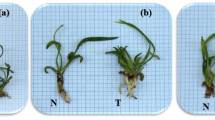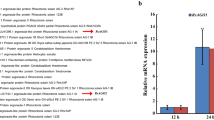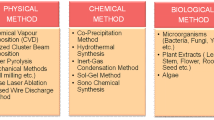Abstract
Background
Transgenic plants are becoming a more powerful tool in modern biotechnology. Genetic engineering was used in biotech-derived products to create genetically modified (GM) plants resistant to diseases. The onion (Allium cepa, L.) is a common, important perennial vegetable crop grown in Egypt for food and economic value. Onions are susceptible to a variety of fungal infections and diseases. Aspergillus niger is a common onion phytopathogen that causes diseases such as black mould (or black rot), which is a major issue, particularly when exporting onions. A. niger grows between the bulb's outer (dead, flaky) skin and the first fleshy scales, which become water-soaked. Thionin genes produce thionin proteins, which have antimicrobial properties against a variety of phytopathogens, including A. niger. Chitosan nanoparticles act as a carrier for the thionin gene, which allows A. cepa to resist infection by A. niger.
Methods and results
Thionin gene (Thio-60) was transformed into A. cepa to be resistance to fungal infection. The gene was loaded on chitosan nanoparticles to be transformed into plants. Transgenic A. cepa had a 27% weight inhibition compared to non-transgenic one, which had a 69% inhibition. The expressed thionin protein has a 52% inhibitory effect on A. niger spore germination. All these findings supported thionin protein's antifungal activity as an antimicrobial peptide. Furthermore, the data presented here demonstrated the efficacy of chitosan nanoparticles in gene transformation.
Conclusion
The present study describes the benefits of producing transgenic onion resistance to black rot diseases via expression of thionin proteins.





Similar content being viewed by others
Data availability
All data materials are available in manuscript.
Code availability
Not applicable.
References
Jurgiel-Malecka G, Gibczynska M, Nawrocka-Pezik M (2015) Comparison of chemical composition of selected cultivars of white, yellow and red onions. Bulg J Agric Sci 21(4):736–741
Karthik SK, Satishkumar PV (2016) Engineering properties of some Indian onion cultivars. Int J Agric Sci 8(29):1613–1617
Wani AH, Taskeen (2011) Management of black mold rot of onion. Mycopath 9:43–49
Saranya R, Anadani VB, Akbari LF, Vanthana M (2017) Management of black mold of onion [Aspergillus niger (Van Teigh)] by using various fungicides. Int J Curr Microbiol App Sci 6(3):1621–1627
Stec B (2006) Plant thionins—the structural perspective. Cell Mol Life Sci 63(12):1370–1385. https://doi.org/10.1007/s00018-005-5574-5
Hoshikawa K, Ishihara G, Takahashi H, Nakamura I (2012) Enhanced resistance to gray mold (Botrytis cinerea) in transgenic potato plants expressing thionin genes isolated from Brassicaceae species. Plant Biotech 29:87–93
Stotz HU, Waller F, Wang K (2013) Innate immunity in plants: the role of antimicrobial peptides. In: Hiemstra S, Zaat SAJ (eds) Antimicrobial peptides and innate immunity. Springer, New York, pp 29–51
Sadati Z, Tajik Ghanbari MA, Babaeizad V, Rahimian H (2014) Expression of thionin and PDF12 coding genes as antimicrobial peptides in interaction of rice against rice blast agent, Magnaporthe oryzea. Iran J Plant Path 50(4):147–149
Kurtoglu KY, Filiz E, Ozyigit II, Vatansever R (2015) Genome-wide analysis of thionin genes in higher plants, plant and animal genome conference XXIII. San Diego, CA. https://pag.confex.com/pag/xxiii/webprogram/Paper14677.html
Odintsova TI, Slezina MP, Istomina EA (2018) Plant thionins: structure, biological functions and potential use in biotechnology. J Genet Breed 22(6):667–675
Hong K, Austerlitz T, Bohlmann T, Bohlmann H (2021) The thionin family of antimicrobial peptides. PLoS ONE 16(7):e0254549. https://doi.org/10.1371/journal.pone.0254549
Asano T, Miwa A, Maeda K, Kimura M, Nishiuchi T (2013) The secreted antifungal protein thionin 2.4 in Arabidopsis thaliana suppresses the toxicity of a fungal fruit body lectin from fusarium graminearum. PLoS Pathog 9(8):e1003581. https://doi.org/10.1371/journal.ppat.1003581
Kavipriya C, Yuvaraja A, Senthil K, Menaka C (2019) Genetic transformation methods for crop improvement: a brief review. Agric Rev 40(4):281–288
Raftery R, O’Brien FJ, Cryan SA (2013) Chitosan for gene delivery and orthopedic tissue engineering applications. Molecules 18:5611–5647
Li G, Wang J, Feng X, Liu Z, Jiang C, Yang J (2015) Preparation and testing of quaternized chitosan nanoparticles as gene delivery vehicles. Appl Biochem Biotechnol 175:3244–3257
Shigemasa Y, Matsuura H, Sashiwa H, Saimoto H (1996) Evaluation of different absorbance ratios from infrared spectroscopy for analyzing the degree of deacetylation in chitin. Int J Biol Macromol 18:237–242
Periayah MH, Halim AS, Saad AZ (2016) Chitosan: a promising marine polysaccharide for biomedical research. Phcog Rev 10:39–42
Seda Tiğli R, Karakeçili A, Gümüşderelioğlu M (2007) In vitro characterization of chitosan scaffolds: Influence of composition and deacetylation degree. J Mater Sci Mater Med 18:1665–1674
Zhang J, Xia W, Liu P, Cheng Q, Tahirou T, Gu W et al (2010) Chitosan modification and pharmaceutical/biomedical applications. Mar Drugs 8:1962–1987
Abdel-Razik AB, Hammad IA, Tawfik E (2017) Transformation of thionin genes using chitosan nanoparticle into potato plant to be resistant to fungal infection. IOSR J Biotechnol Biochem 3(3):1–13
Murashige T, Skoog K (1962) A revised medium for rapid growth and bioassays with tobacco tissue cultures. Physiol Plant 15:473–497
Lu Y, Chanroj S, Zulkifli L, Johnson MA, Uozumi N, Cheung A, Sze H (2011) Pollen tubes lacking a pair of K+ transporters fail to target ovules in Arabidopsis. Plant Cell 23(1):81–93
Czechowska-Biskup R, Jarosińska D, Rokita B, Ulański P, Rosiak JM (2012) Determination of degree of deacetylation of chitosan—comparison of methods. Prog Chem Appl Chitin Deriv 17:5–20
Kiang T, Wen J, Lim HW, Leong KW (2004) The effect of the degree of chitosan deacetylation on the efficiency of gene transfection. Biomaterials 25:5293–5301
Mansouri S, Cuie Y, Winnik F, Shi Q, Lavigne P, Benderdour M, Beaumont E (2006) Characterization of folate-chitosan-DNA nanoparticles for gene therapy. Biomaterials 27:2060–2065
Khan RS, Sjahril R, Nakamura I, Mii M (2008) Production of transgenic potato exhibiting enhanced resistance to fungal infections and herbicide applications. Plant Biotechnol Rep 2:13–20
Khan RS, Ntui VO, Chin DP, Nakamura I, Mii M (2011) Production of marker-free disease-resistant potato using isopentenyl transferase gene as a positive selection marker. Plant Cell Rep 30:587–597
Bradford MM (1976) A rapid and sensitive method for the quantitation of microgram quantities of protein utilizing the principle of protein-dye binding. Anal Biochem 72:248–254
Maji MD, Chattopadhyay S, Kumar P, Saratchandra B (2005) In vitro screening of some plants extracts against fungal pathogens of mulberry (Morus spp). Arch Phytopathol Plant Prot 38:157–164
Liu Y, Luo J, Xu C, Ren F, Peng C, Wu G, Zhao J (2000) Purification, characterization, and molecular cloning of the gene of a seed-specific antimicrobial protein from pokeweed. Plant Physiol 122:1015–1024
Plattner S, Gruber C, Stadlmann J, Widmann S, Gruber CW, Altmann F, Bohlmann H (2015) Isolation and characterization of a thionin proprotein processing enzyme from barley. J Biol Chem 290(29):18056–18067
Almaghrabi B, Ali MA, Zahoor A, Shah KH, Bohlmann H (2019) Arabidopsis thionin-like genes are involved in resistance against the beet-cyst nematode (Heterodera schachtii). Plant Physiol Biochem 140:55–67
Hussien ET (2020) Production of transgenic Paulownia tomentosa (Thunb.) steud. using chitosan nanoparticles to express antimicrobial genes resistant to bacterial infection. Mol Biol Res Commun 9(2):55–62
Bivas-Benita M, Romeijn S, Junginger HE, Borchard G (2004) PLGA-PEI nanoparticles for gene delivery to pulmonary epithelium. Eur J Pharm Biopharm 58:1–6
Hallaj-Nezhadietel S, Valizadeha H, Dastmalchia S, Baradaranc B, Jalalia MB, Dobakhtid F, Lotfipoure F (2011) Preparation of chitosan-plasmid DNA nanoparticles encoding interleukin-12 and their expression in CT-26 colon carcinoma cells. J Pharm Pharmaceut Sci 14(2):181–195
Cammue BPAD, Bolle MFC, Terras FRG, Proost P, Van Damme J, Rees SB, Vanderleyden J, Broekaert WF (1992) Isolation and characterization of a novel class of plant antimicrobial peptides from Mirabilis jalapa L. seeds. J Biol Chem 267:2228–2233
Epple P, Apel K, Bohlmann H (1997) Overexpression of an endogenous thionin enhances resistance of Arabidopsis against Fusarium oxysporum. Plant Cell 9(4):509–520
Acknowledgements
The authors would like to thank both the Botany and Microbiology Department – Faculty of Science – Helwan University, and Agriculture Center for of Genetic Engineering and Biotechnology (ACGEB) – Faculty of Agriculture – Ain Shams University.
Funding
No funding received for this work.
Author information
Authors and Affiliations
Corresponding author
Ethics declarations
Conflict of interest
All authors have nothing to disclose.
Consent to participate
All authors agree to the content of manuscript.
Consent for publication
All authors agree for publication.
Ethical approval
Not applicable.
Additional information
Publisher's Note
Springer Nature remains neutral with regard to jurisdictional claims in published maps and institutional affiliations.
Rights and permissions
About this article
Cite this article
Tawfik, E., Hammad, I. & Bakry, A. Production of transgenic Allium cepa by nanoparticles to resist Aspergillus niger infection. Mol Biol Rep 49, 1783–1790 (2022). https://doi.org/10.1007/s11033-021-06988-5
Received:
Accepted:
Published:
Issue Date:
DOI: https://doi.org/10.1007/s11033-021-06988-5




